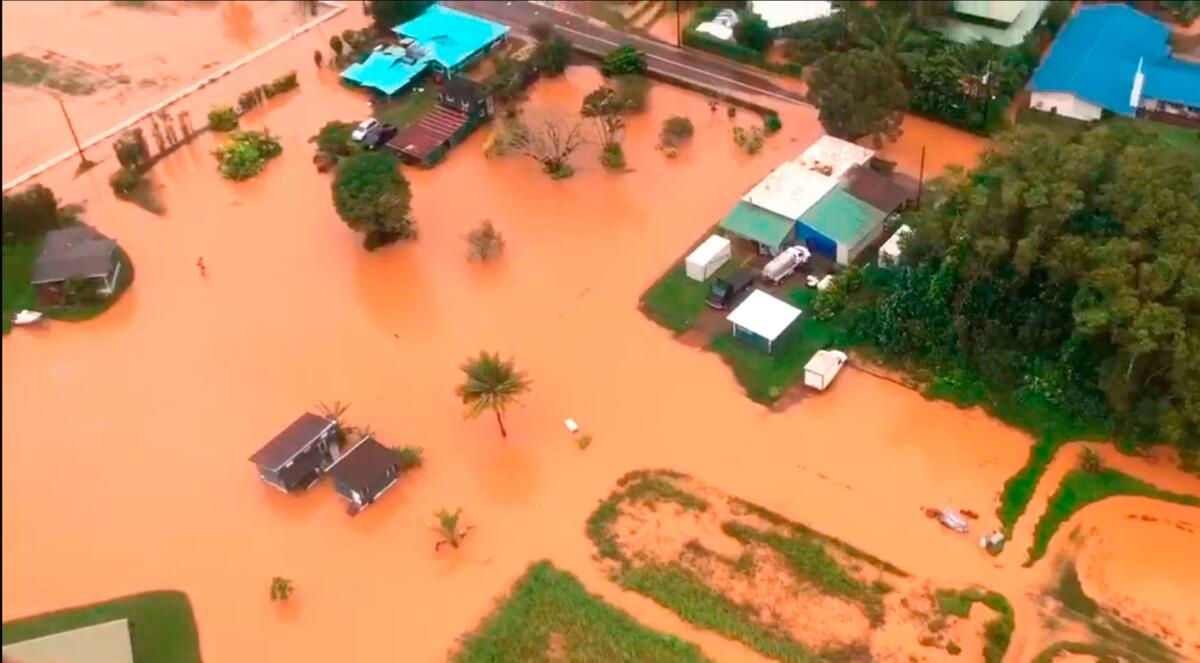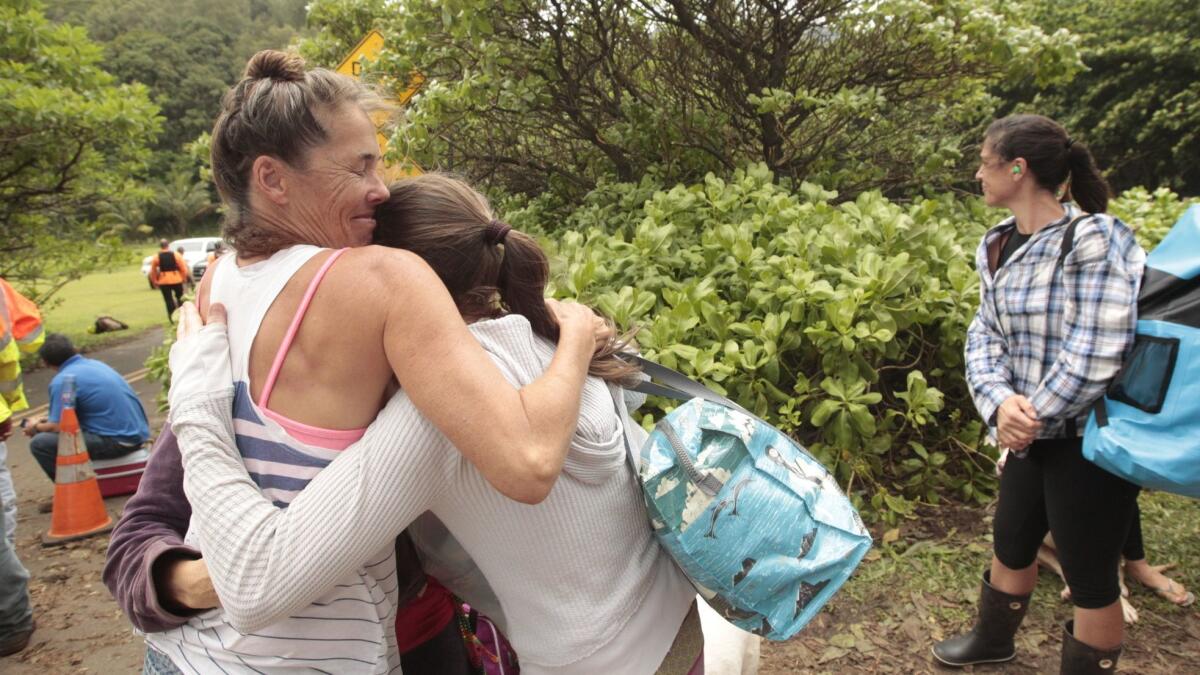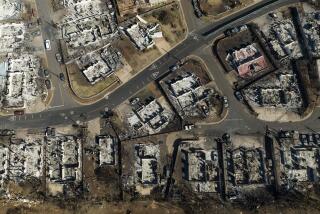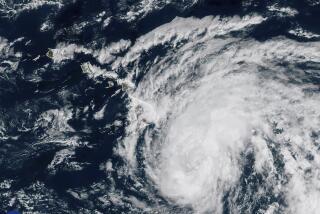A Hawaiian island got about 50 inches of rain in 24 hours. Scientists warn it’s a sign of the future

- Share via
Reporting from HONOLULU — Since the 1940s, the Hawaiian island of Kauai has endured two tsunamis and two hurricanes, but locals say they have never experienced anything like the thunderstorm that drenched the island this month.
“The rain gauge in Hanalei broke at 28 inches within 24 hours,” said state Rep. Nadine Nakamura of the North Shore community. “In a neighboring valley, their rain gauge showed 44 inches within 24 hours. It’s off the charts.”
Actually, it was even worse. This week the National Weather Service said nearly 50 inches of rain fell in 24 hours.
Now, as Kauai continues to recover, scientists warn that this deluge on April 14 and 15 was something new — the first major storm in Hawaii linked to climate change.
“The flooding on Kauai is consistent with an extreme rainfall that comes with a warmer atmosphere,” said Chip Fletcher, a leading expert on the impact of climate change on Pacific island communities.
He noted that the intense rainfall not only triggered landslides, it also caused the Hanalei River to flood and carve a new path through Hanalei. Homes, cars and animals were swept away in raging waters, but no residents or visitors died. Some were airlifted to safety or rescued by boat.
Members of a bison herd were displaced or carried off by floodwaters, and some were rescued from the ocean after swimming for their lives. “Poor buffalo,” said Sue Kanoho, executive director of the Kauai Visitors Bureau, who saw video and photos of the animals roaming around businesses and neighborhoods.

The picturesque North Shore communities of Wainiha and Haena are considered the hardest-hit because the only road that leads to them, Kuhio Highway, is now blocked by landslides. Officials say it may not fully reopen for months.
So what can we expect in the future?
“Just recognize that we’re moving into a new climate, and our communities are scaled and built for a climate that no longer exists,” said Fletcher, a professor of geology and geophysics at the University of Hawaii at Manoa.
Kawika Winter, a natural resource manager, put the storm in perspective.
“This is the most severe rain event [in Hawaii] that we know about since records started being kept in 1905,” Winter said as he was about to catch a boat from Hanalei to join recovery efforts in Haena. “We’re the most remote community on the North Shore, which is why being cut off is extremely devastating.”
Winter is involved in research on climate change and community resilience — the ways places recover from unexpected and catastrophic events.
“In the Pacific Islands, we don’t have the luxury of debating whether climate change is real,” he said. “Climate change is affecting us, and has been for some time. There are striking similarities with the flooding that we experienced on Kauai and the recent flooding in California. The warmer atmosphere is holding more moisture and that builds up until it meets with cold dry air, creating this massive unstable system, which causes what some meteorologists are now referring to as a ‘rain bomb.’”
This week, a study published in the scientific journal Nature Climate Change said that California can expect more volatile weather — swinging from dry to wet years — because of human-caused climate change.
For about a week after the storm, the normally aquamarine ocean around the island was an eerie orange — a sign of the volcanic soil. The more iron in the lava, the more orange the soil, said Dolan Eversole, a coastal geologist with the University of Hawaii Sea Grant College Program.
Since Kauai is the oldest of the Hawaiian Islands, the mountains are exceptionally steep and the distance between the mountaintops, where it rained, and the sea is relatively short. There was no time for the red-orange clay to settle as water raced out to sea, he said.
The Federal Emergency Management Agency and state and county officials on Kauai are still assessing the damage to homes, infrastructure and businesses.
“People are struggling because they’re cut off from their friends and family and jobs. That’s heartbreaking,” said Nakamura, who represents the North Shore area.
Among the places cut off by landslides is the Limahuli Garden and Preserve in Haena, one of the economic engines in the area. The botanical garden and nature preserve is set within Limahuli Valley, which attracts locals and visitors from around the world — but it has shut down and is not expected to reopen for months.
Flooding has destroyed parts of the garden. “It was damaging, but not catastrophic. We can recover,” said Winter, director of the garden and preserve. “However, the nature preserve is home to dozens of critically endangered plants and birds. We’re still assessing the damage to those species.”
Limahuli is one of the last places where you can see how Native Hawaiians traditionally managed community resources from the mountains to the sea and continue to perpetuate those practices today.
The valley also was a setting for the musical “South Pacific,” with the sacred mountain Makana, towering over the valley, serving as Bali Hai in the movie. And remember the scene in “Jurassic Park” when a cow was lowered into a pen to feed the velociraptors? It was also filmed there.
One of the community leaders in Haena is Presley Wann, who has also been helping with relief efforts. “I’m amazed nobody was killed. There’s so much to do now, it’s overwhelming.”
Wann’s family owns ancestral lands in Haena, which is surrounded by property owned by celebrities, including Julia Roberts, Bette Midler and the family of the late Glenn Frey.
Mark Zuckerberg and Pierre Omidyar also have landholdings on the North Shore. Zuckerberg has pledged $1 million to help the island recover. Omidyar donated $100,000 to establish the Kauai Relief and Recovery Fund through the Hawaii Community Foundation.
Kauai has weathered a lot over the years. It survived the 1946 tsunami, which damaged all the islands. Another tsunami in 1957 hit Kauai with waves up to 52 feet high.
When Hurricane Iwa swept the Garden Island in 1982 it did about $250 million in damage.
In 1992, Hurricane Iniki, the most powerful to strike the islands in recorded history, killed six people on Kauai, and damaged or destroyed more than 14,000 homes. Damage totaled $3 billion.
“People have been describing this latest storm as a 100-year-flood,” Winter said. “But it’s more likely that the next one is just a few years off, given the reality of climate change.
“When natural disasters hit, communities have to fend for themselves. Since several generations have recovered over the years, it helps to build resilience in the community. And now, how it rebuilds could be an example for others.”
Chang is a special correspondent.
More to Read
Sign up for Essential California
The most important California stories and recommendations in your inbox every morning.
You may occasionally receive promotional content from the Los Angeles Times.










